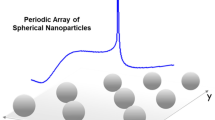Abstract
Phenomena of total reflection and total transmission are studied in the case of quantum particle 3D scattering on 2D periodic zero-range potentials. The general case is considered where the target is a “molecular monolayer” obtained by 2D periodic mapping of N different zero-range potential scattering centers. This is an infinite multicenter and multichannel scattering problem. It turns out that many of the global properties of reflection and transmission coefficients are determined by phenomena which occur at thresholds for opening of new scattering channels. We have performed detailed numerical studies for the cases when \(N=1\) (atomic monolayers) and \(N=2\) (planar and non-planar diatomic monolayers, that is atomic bilayers) on square and honeycomb lattices. In these cases, many interesting predictions can be derived analytically. We have also addressed the problem of the quasi-2D localized states embedded in continuum, that is, the band structures above the vacuum level.
Graphic abstract














Similar content being viewed by others
Data Availability Statement
This manuscript has no associated data or the data will not be deposited. [Authors’ comment: This is a theoretical study and there are no experimental data.]
References
B. Shevitski, M. Mecklenburg, W.A. Hubbard, E.R. White, B. Dawson, M.S. Lodge, M. Ishigami, B.C. Regan, Phys. Rev. B 87, 045417 (2013)
R.M. Feenstra, N. Srivastava, Q. Gao, M. Widom, B. Diaconescu, T. Ohta, G.L. Kellogg, J.T. Robinson, I.V. Vlassiouk, Phys. Rev. B 87, 041406(R) (2013)
J. Jobst, J. Kautz, D. Geelen, R.M. Tromp, S.J. van der Molen, Nat. Commun. 6, 8926 (2015)
F. Wicki, J.N. Longchamp, T. Latychevskaia, C. Escher, H.W. Fink, Phys. Rev. B 94, 075424 (2016)
P.S. Neu, D. Geelen, A. Thete, R.M. Tromp, S.J. van der Molen, Ultramicroscopy 222, 113199 (2021)
V.U. Nazarov, E.E. Krasovskii, V.M. Silkin, Phys. Rev. B 87, 041405(R) (2013)
J.A. Yan, J.A. Driscoll, B.K. Wyatt, K. Varga, S.T. Pantelides, Phys. Rev. B 84, 224117 (2011)
H. Miyauchi, Y. Ueda, Y. Suzuki, K. Watanabe, Phys. Rev. B 95, 125425 (2017)
N. Markovska, J. Pop-Jordanov, E.A. Solov’ev, Phys. Lett. A 234, 251 (1997)
Y.N. Demkov, V.N. Ostrovskii, Zero-Range Potentials and Their Applications in Atomic Physics (Plenum Press, New York, 1988)
S. Albeverio, F. Gesztesy, R. Hoegh-Krohn, H. Holden, Solvable Models in Quantum Mechanics (AMS Chelsea Publishing, Providence, 2005)
K. Kambe, Z. Naturforschg. 23a, 422 (1967)
E.G. McRae, J. Chem. Phys. 45, 3258 (1966)
D. Maystre, in Plasmonics. ed. by S. Enoch, N. Bond (Springer, Berlin, 2012), pp. 39–83
Y.E. Karpeshina, Theor. Math. Phys. 57, 1231 (1983)
A. Grossmann, R. Hoegh-Krohn, M. Mebkhout, Commun. Math. Phys. 77, 87 (1980)
T.P. Grozdanov, M.J. Raković, Phys. Rev. A 47, 3105 (1993)
I. Stevanović, P. Crespo-Valero, K. Blagović, F. Bongard, J.R. Mosig, IEEE Trans. Microw. Theory Tech. 54, 3688 (2007)
Acknowledgements
This work was supported by Serbia-JINR collaboration program.
Author information
Authors and Affiliations
Contributions
Both authors contributed equally to the paper.
Corresponding author
Appendices
Appendix A: Lattice sums
For numerical calculations of lattice sums we used formulas (32) and (33) from [13] obtained by Ewald’s method (taking into account that our definition of lattice sums has an extra factor \(\exp (i\mathbf{q}\cdot {\mathbf {\rho }})\)):
The presence of complementary error functions makes the above sums rapidly convergent. The optimal choice of Ewald’s separation parameter, \(\eta _{opt}=\sqrt{\pi /A}\) guarantees that approximately equal number of terms in sums over \(\mathbf{n}\) and \(\mathbf{m}\) are necessary to achieve the convergence. However, as discussed in [18], at high energies the loss of numerical accuracy occurs due to subtractions of large terms of the order of \(\exp (k^2/(4\eta ^2))\). To limit this exponent to maximum value of \(\exp (H^2)\) one has to choose
In all our calculations, we obtained stable results with \(H=3\).
Another useful form of \(S_{k,\mathbf{q}}'(\mathbf{0}, 0)\) was derived in [11] (equation 1.6.26, p.214),
where \(k_{z\mathbf{m}}\) is defined in (14). For the scattering problems \(q^2< k^2<+\infty \), we have
For band structures, in the interval \( 0<k^2<q^2\), we have
while in the interval \( -\infty<k^2<0\) (\(k=i|k|\)) we have
Appendix B: Zeroth threshold
For the zeroth threshold (\(t=0\)) we have \(k_0=0, k_{z 0}=k_z, N_0=1, \mathbf{m}_1^0=(0,0),\tilde{\mathbf{q}}_{\mathbf{m}^0_1}=0, \tilde{S}^0_{jj'}=1\). Consequently, \(\det \tilde{\mathbf{S}}^0=1,0\) for \(N=1,N>1\) and \(\det \tilde{\mathbf{S}}^{jj'0}=1,1,0\) for \(N=1,2,N>2\). Direct calculations using (45) for \(N=1\) and \(N=2\) show that \({\tilde{A}}_{\mathbf{0}}^{\pm }= -1\) (see also Sects. 6 and 7). In the case \(N>2\), we find
It can be shown that
and consequently
Taking into account that the exponent in (45) is equal to 1 at \(k=0\), and substituting (B.11) and (B.15) in (45), we find that \({\tilde{A}}_{\mathbf{0}}^{\pm }=-1\).
Rights and permissions
About this article
Cite this article
Grozdanov, T.P., Solov’ev, E.A. 3D scattering by 2D periodic zero-range potentials: total reflection/transmission and threshold effects. Eur. Phys. J. B 95, 16 (2022). https://doi.org/10.1140/epjb/s10051-022-00279-z
Received:
Accepted:
Published:
DOI: https://doi.org/10.1140/epjb/s10051-022-00279-z




